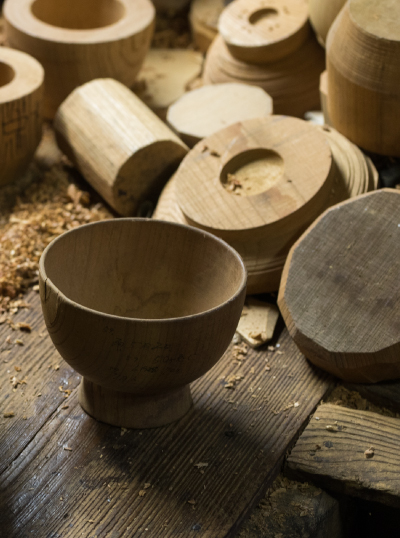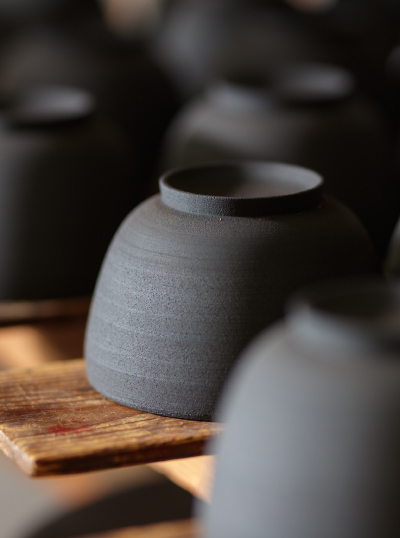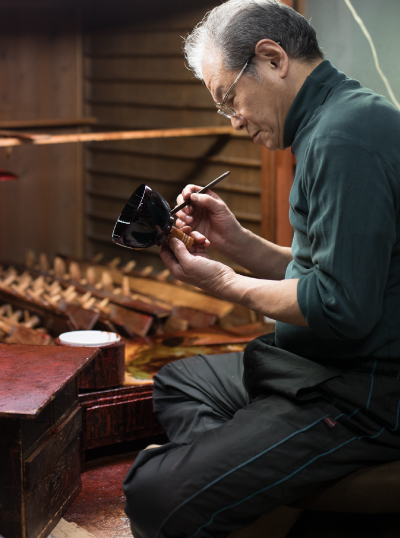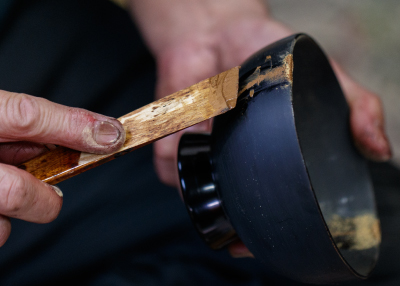The history of Ichimatsu
About NUSHIYA
Nushiya Ichimatsu has been inherited for three generations. Kitarou established the company, the second is Haruo, and now the third is Satoshi. Although it is only the third generation as a Nushiya, some of the family of Ichimatsu was engaged in Wajima-nuri for generations because it is a traditional major product of Wajima. For instance, the wife of the first generation was involved in it as a specialist in polish.
Nushi literally means the person who play the role of the Wajima-nuri’s “painting” process. However, it is said that Nusiya basically play an role of both painting process and selling the lacquerware. Moreover, Nushiya plays several roles, they are at once a “salesman” who consults with customers and receive their orders, and “director” who tells orders for craftsmen, and a “producer” who plans what kinds of products making.
We make designs such as the shape and pattern for each customer by consulting their preference. There are expert craftsmen for each Wajima-nuri’s process as follows, craftsmen of kiji (wooden base), craftsmen of shitaji (base coating), craftsmen of nakanuri (internal coating), craftsmen of uwanuri (top coating), craftsmen of maki-e (painting the pattern), craftsmen of chin-kinn (putting on the gold into the pattern), craftsmen of togimono (sharpening), craftsmen of roiro (glazing).
Nushiya directly consults with the customer, and there are following five processes for producing products. First, decide the type of wood for the wooden base and request craftsmen of kiji. Second, base costing by craftsmen of shitaji. Third, the internal coating, middle coating, and top coating by Nurishi. Forth, decorating by craftsmen of maki-e and craftsmen of chin- kinn. Fifth, polishing and glazing by craftsmen of roiro.
About Haruo Ichimatsu (the second)
The second Haruo Ichimatsu is a Nurishi who took over Nushiya business as a livelihood. He has produced the products as a craftsman specializing in “painting” to pursue a unique worldview still now.
-Profile -
The craftsman of Wajima-nuri Haruo Ichimatsu
He was born in Wajima city in 1945. He had worked as an Automotive Technician level 2 until he was 27 years old. After that, he engaged in the family business Wajima-nuri. In 1966, [ Nushiya Urushinoki] opened the store in Kazue-machi, Kanazawa city. He was introduced as a conservator of Wajima-nuri by some social media such as TV and magazines. The action caught the eye of artist Mr. Keiichi Tahara, and the work painted upon request from him were published in Fujin Gaho (Japanese monthly women’s magazine). Also, the work was displayed at Tokyo Metropolitan Teien Art Museum. After that, he have been engaged in a lot of work as well.
About the workshop
All procedures are managed by one workshop
Wajima-nuri makes into a product through about 100 processes, and it was divided into the following three stages, “making the wooden base,” which makes the shape of the bowl, “painting Japanese lacquer, 漆 urushi” which paints urushi on the wooden base, and “decorating” which decorates the bowl with gold inlay. Among them, the process of painting has 23 stages. In general, this process is divided into multiple workshops. However, Ichimatsu’s feature is conducting all of the painting processes in one workshop. Even for only the painting process, generally there is a different craftsman for every single painting process. Although they are professionals of the certain Wajima-nuri’s process, that way makes the quality of work unequal for each process because the lack of interference with other process’s craftsmen makes it difficult to share their concept. Ichimatsu deals with this issue by taking the system “All procedures are managed by one workshop, “ and it enable us to provide high-quality products with impartial techniques and grades.
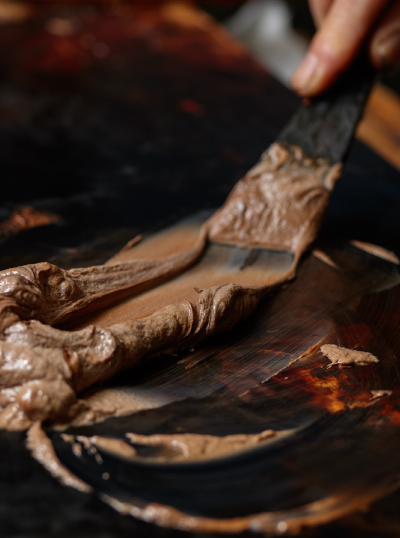
“Repair items Naoshimono - maintenance”
In Wajima-nuri, repair items call naosimono. We Ichimatsu receive the order of repairment and maintenance according to the conditions of each lacquerware, such as the breaks and dullness. After the repairment, the works become like same as the new one since Wajima-nuri are made by using only natural materials, and we also use the same materials for the repairments. We exert ourselves for customers be able to use their precious lacquerware for a long time, whereas it takes a while since the craftsmen make a great effort to repair them. Please contact us who think about the repair, maintenance, and remake of lacquerware, even if it is not Wajima-nuri.
The Overview of Workshop
MADE BY ICHIMATSU
Our workshop is located apart from the center of Wajima-city and is filled with nature, surrounded by mountains and rivers. There are a lot of workshops which support the small-medium Wajima-nuri business, such as Kijiya and Nushiya around Fugeshi River. Every workshop support Wajima-nuri with techniques handed down from generation to generation. Nushiya Ichimatsu is also one of them.
workshop
Nushiya Ichimatsu
37-4, Nagaguchi, Chudamachi, Wajima-shi, Ishikawa-ken, Japan, 928-0041
TEL/FAX0768-22-7546
Copyright © 2022 Urushinoki All Rights Reserved

